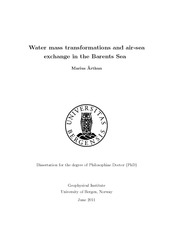| dc.contributor.author | Årthun, Marius | eng |
| dc.date.accessioned | 2011-10-20T11:39:34Z | |
| dc.date.available | 2011-10-20T11:39:34Z | |
| dc.date.issued | 2011-09-22 | eng |
| dc.identifier.isbn | 978-82-308-1822-0 (print version) | en_US |
| dc.identifier.uri | https://hdl.handle.net/1956/5127 | |
| dc.description.abstract | Water mass transformation processes in the Barents Sea and their interannual to decadal variability are studied using a regional coupled ice-ocean model and observational data. Long-term data allows for assessment of temporal and spatial variability in water mass properties and distribution, and the influence on air-sea exchange of heat and CO2. The Barents Sea ocean climate shows substantial interannual to decadal variability between 1948 and 2007. Variations in ocean heat transport associated with the Atlantic inflow modulate both the Barents Sea mean temperature (heat content) and the sea-ice extent. An increasing ocean heat transport is largely responsible for the sea-ice retreat in the Barents Sea during recent decades. The increased open ocean area causes a larger heat loss to the atmosphere, which provides sufficient cooling to transform a majority of the warm Atlantic inflow into cold, dense water before it is exported into the deep Arctic Ocean. The Barents Sea is thus an effective ocean cooler, and the dense outflow into the Arctic Ocean displays large variability, corresponding to variations in the Atlantic inflow. Variability of water mass transformation processes related to changes in surface heat loss, sea-ice growth and corresponding salt fluxes, and the surface salinity before winter, also leads to substantial variations in the thermohaline properties of dense water. In the southern Barents Sea this is associated with the Atlantic inflow and thus the regional climate, whereas variable preconditioning of surface waters by ice melt and fresh coastal waters are more important in the northern Barents Sea. Oceanic heat loss and convective processes also favor an uptake of atmospheric CO2. Calculated air-sea CO2 fluxes for the period 2000-2007 identifies the southern Barents Sea as a particularly efficient sink of atmospheric CO2. Temporal and spatial variability of water mass properties and sea-ice extent are important to the CO2 uptake, although wind speed is the major driver of variability. | en_US |
| dc.language.iso | eng | eng |
| dc.publisher | The University of Bergen | en_US |
| dc.relation.haspart | Paper I: Årthun, M. and Schrum, C., Ocean surface heat flux variability in the Barents Sea1 Journal of Marine Systems, 83, 88-98. The published version is available at: <a href="http://dx.doi.org/10.1016/j.jmarsys.2010.07.003" target="blank">http://dx.doi.org/10.1016/j.jmarsys.2010.07.003</a> | en_US |
| dc.relation.haspart | Paper II: M. Årthun; T. Eldevik; L. H. Smedsrud; Ø. Skagseth, Barents Sea ice cover reflects Atlantic inflow. Submitted to Elsevier. <a href="http://hdl.handle.net/1956/5126" target="blank">http://hdl.handle.net/1956/5126</a> | en_US |
| dc.relation.haspart | Paper III: M. Årthun; R. B. Ingvaldsen; L. H. Smedsrud;, C. Schrum, Dense water formation and circulation in the Barents Sea. Submitted to Deep-Sea Research Part I. <a href="http://hdl.handle.net/1956/5125" target="blank">http://hdl.handle.net/1956/5125</a> | en_US |
| dc.relation.haspart | Paper IV: M. Årthun; R. G. J. Bellerby; A. M. Omar; C. Schrum, Air-sea CO2 fluxes in the Barents Sea as determined from empirical relationships.Full text not available in BORA. | en_US |
| dc.title | Water mass transformations and air-sea exchange in the Barents Sea | en_US |
| dc.type | Doctoral thesis | |
| dc.rights.holder | Copyright the author. All rights reserved | en_US |
| dc.subject.nsi | VDP::Mathematics and natural science: 400::Geosciences: 450::Oceanography: 452 | en_US |
